20 - 24 April 2010
Tuesday 20 th April: Attendance: 3 The mission today was to shunt D8233 back to 6 road at the loco works. Using Class 01 D2956 we shunted D8233 from 4 road at Castlecroft, then headed through the station and arrived at Baron Streer. Once checking with the shed foreman we brought the 01 and D8233 round to the works yard. Once another shunt of steam locos had been completed we then, using 08479, proceeded to shunt out all of 6 road, D2956 then added D8233 to the consist and it was then shunted back up 6 road. The 08 was then returned to the works team and the 01 moved to the engineers sidings and disposed of. With the shunt completed at 11.30am Chris Tatton & myself then headed for home at was the end of a long 4 days. We would like to take this opportunity to thanks the following for making the refit of the generator go as swiftly as possible: Mike Smith of Dowding & Mills, Carl Holt, Andy Hardman, Nick Hewitt, Rob Mason, Jason Lovell, Chris Tatton, Adam Booth, Adrian Henderson, Kevin Cook & Carl Westwood. Once the shunt was completed the rest of the volunteers made an early departure for home, this left Jason behind who would remain on site to continue working on D8233 for the rest of the week as he'd been given an important and specific task to complete on the loco, Refitting the L/H exhaust system to the Engine, however before a start could be made on this both D8233 & D5705 needed to be reconnected to power supplies and as both locos were now in different positions on the siding than they were before the original power cables did not reach anymore so for the best part of the afternoon Jason would get both the locos plugged back into mains supplies. The Co-bo was tackled first and it was found that simply by removing the existing cable and laying down a new extension it could be plugged back into the power socket it used before, the only difference being was that the RCD switch unit that protected the loco power lead needed to repositioned onto the loco as it had previously been attached to D8233, this was placed in a convenient position on D5705 and the lead has been installed so that it can easily be unplugged if the loco needs to shunted out again. D8233 is now way out of its original siding position, its not only the other side of Paddy which now sits in its spot but it's the opposite side of the Co-bo too, so its too far away from its original power supply to be able to extent to it, so a redundant power lead that is on the floor next to the loco was utilised to plug it in, but first Jason had to take a trip down to B&Q to buy a second RDC switch unit, this was wired in and located in a accessible position under the loco frames, again like the co-bo it has a plug on the off side that can be easily detached to make it safe to shunt also there are no loose cables crossing the rails, with that done both systems were tested successfully. Meanwhile the ELR JCB digger came down to the Co-bo tent and driver Phil Bailey had come to dig a shallow trench around the front and side of the tent to hopefully divert the flood water that steams down the car park when it rails heavily, Phil then set up to dig the trench but found the going tough on the dry and hard gravely dirt, Jason oversaw the operation and the trench starts at the cobbles alongside the covered up Crossley HSTV12 and then ran diagonally out to opposite side of the tent, it then runs parallel to the side of the tent (about 3 meters away) to just past the end of the tent, the gravel dug out of the trench was used to make a small dam to the sides, after he had finished Phil departed with the Digger and it only remains now to see if the “River Crossley” flood defences actually work. After this Jason returned to D8233 and went inside to rig up the internal lighting that had been taken down when the roof was removed, once done he bolted up the lifting bean across the backs of the side frames to provide some support and stop the frame s from flexing, that bought an end to the afternoons efforts. Wednesday 21 st April Jason had quite a task ahead of him, that is to refit the Exhaust manifolds to the L/H side of the engine, now that the Generator has returned work can concentrate on reconnecting the engine ready for a 2 nd start up attempt, however there is much work to be done before this can happen and refitting the L/H exhaust is a major part of these preparations, The exhaust was originally removed so that access could be gained to paint the engine block as much of the side of the engine is obscured by the extensive manifold system, before Jason could start putting back the manifold pipes he first had to complete the painting of the L/H side of the power unit, so during the morning he gloss painted the Inlet manifold, the L/H/F corner of the engine, the Cylinder heads, Cylinder water jackets and the side of the crank case in fact everything down to the bed plate except the oil & water as they needed to be painted a different colour later on, to finish of with the wood pigeon gloss he then painted the Turbo manifold pipe and after this job was completed Jason went back to the support coach and begin preparing the manifold pipes for fitting. After some lunch Jason set up on the outside bench and drelled up the mounting flanges and ring joints on the first lot of pipes he was to fit, now the large manifolds require lagging with heat resistant tape, some new fibreglass braded insulation wrap has been acquired for this task, Jason then wound the tape around the first pipe and cut the end off, now normally exhaust lagging such as this would be secured with wire wrapped around, but as Jason had none to hand at the time he used red insulation tape wrapped around the ends of the lagging to secure it to the pipes, this is a temporary measure as some wire will need to be acquired and fitted at a later date. Jason then went into the loco and fitted to the first short flange pipes that fit into the cooling knuckle attached to the turbo, now these short pipes all have ring joints on them, there are four grooves into which compression rings fit much like the piston rings on a car engine, the pipes are a close fit into the bores on the knuckle and its difficult to compress the rings and slot in the pipe? Jason then came up with a plan, using two large jubilee clips cut to length, these were fitted over and tightened onto two of the four rings (there being two clips to each pipe) the trick is to make sure that they are not over tightened so that the rings can still slip round in there grooves, then the pipe is aligned with the bore and gradually tapped home evenly using a light hammer blows at opposite sides to each other upon the flange face of the pipe, as the pipe is pushed in the rings go in and the jubilee clips get pushed out eventually the pipe is fully home and the loose jubilee clips can be undone and removed. This process needed to be repeated four times before all four of the short flange pipes were fully mounted, do to the close fitting of the exhaust branches some fine twisting of the flange joints was required before they would line up properly, after this Jason returned to the outside workbench and drelled and lagged up the next three manifold pipes ready for fitting the following day, to finish off the afternoon, he returned to the engine compartment and painted the oil pipes with gloss paint that run along the L/H side of the engine, that completed the days tasks. Thursday 22 nd April. Today would see the real start of the exhaust reassembly, up to now all Jason had fitted was the short stubby flange pipes into the turbo cooling knuckle, but today the main manifold pipes would at last part to be re-attached, the exhaust system on the Paxman 16HYXL is quite possibly one of the most complicated ever fitted to an engine, on each bank of the ‘Vee' are 8 cylinders, the exhaust has 4 branches that are arranged in layers and each serve 2 cylinders each and these are grouped into symmetrical pairs, (I.E 1-8, 2-7, 3-6 & 4-5) the exhaust system is split into front and rear sections by a intermediate cooling knuckle situated between cylinders 5 & 6, the exhaust has 19 separate manifold pipes held together by 88 - 9/16 th AF bolts, it's a complicated close fitting assembly that would test Jason's dexterity & patience to the limit! The day began with Jason fitting the flange pipes into the central cooling knuckle using the jubilee clip ring compression technique to insert the three rear pipes into the knuckle he also had to clean off the paint that had been applied to the bolted flange joints on each side, the next task he had to perform was enter to the loco and detail paint the coolant manifold that feeds into the base of each cylinder water jacket, this was painted gloss blue to signify that the pipe carries water, one this was done Jason had to take a trip down to the secure store house to check the gasket set that came with the loco to see if there were any exhaust manifolds there and as luck would have it a full set of new cylinder head gaskets was found and taken back down to the coach. As the fuel system will need to be refitted shortly as part of the work to get the engine ready for start-up, the remaining section of roof that requires gloss painting is right behind where the fuel pipes attach to the roof section, this needs to gloss painted as soon as possible but it had only just been drelled & primer painted on the Sunday. So Jason decided to move things along a bit and painted on the grey undercoat to all the remaining roof areas that had been primer painted a few days previous now all that remains is for Rob Mason to finish off the glossing when he next comes up and all will prepared for the fuel pipes to be re-installed. The next task was an odious one, cleaning up all the little nuts and bolts that make up the exhaust system, Jason decided to go to town in this respect and did a thorough job of cleaning all the small nuts and bolts, he also fitted spring washers throughout replacing ones that were missing and he even managed to find a tap & die of the correct thread and tapped out all the nuts using a drill and any bolts with damaged threads were cleaned up using the die, everything else was polished up using the wire wheel on the bench grinder, however Jason did not clean up all the bolts in one go instead he only treated enough bolts for the pipes he was fitting at the time and this meant he had to keep coming back and spending more time doing this chore but the end result was well worth the effort as all the bolts threaded beautifully back into place when refitted. After cleaning up the bolts he needed it was time to fit the first main manifold pipe, this was just a long straight pipe that runs at the bottom, being on his own it was tricky to hold the pipe and fit the flange bolts. In the end he had to resort to tying the other end of the pipe up with a bit of rope to hold it up while he fitted the bolts and tightened up the flange, after this is was a case of building the manifolds up one at a time from the bottom up, the next one had a flange for cylinder head No. 8, but before this could be fitted all the head flange seats had to drelled and the threaded bolts holes cleaned out using the drill & tap, that done the manifold could be fitted, now this proved to be trickier than it looks, the pipe bolts firmly and squarely onto the heat, but the flange pipe must be pulled up to it and aligned correctly before bolting down, also some of the fire rings in these joints were loose and had an annoying habit of falling out, Jason soon found that you had to keep the bolts on to the head loose while you fitted the flange, this would be common problem throughout the remaining assembly of the exhaust, only when all the bolts started & pipes were aligned could everything be tightened up, Jason struggled on fit the other two branch pipes to the back section before he came to his next hurdle, the central cooling knuckle… The main problem with the central knuckle is that it's not actually bolted to the engine block in any way. It is fully supported by the exhaust manifolds and as such is an integral part of the exhaust system assembly, the knuckle is flange bolted to two pipes, the rear top pipe and front bottom one, this means that the fitting of the unit is crucial any mis-alignment and it just won't fit, its also rather heavy and a really awkward shape to handle.It was getting late in the day and Jason really wanted to get this part on before the end of play, so he struggled for sometime to get the flange holes lined up and had to try 3-4 times to get the bolts started but eventually he managed it and breathed a sigh of relief, he decided to leave the job of connecting up the flanges to the rear section pipes until the following day and set about packing things up still it had been a very productive day with half the exhaust now back in situ. Friday 23 rd April . Jason started up early today as he was keen to get the remainder of the exhaust re-fitted today, so he started things off with another drelling session with the nuts & bolts he would be needing for the next phase of the job, this as before was quite time consuming and took nearly two hours to do, while doing this he decided to separate the sections of the front manifolds so that he could get the flange pipes off and cleaned up ready for tapping into the central cooling knuckle. However, when he tried the bolts they were seized and forcing them only caused them to snap, obviously these pipes had gotten really hot in the past and cooked the bolts to make them seize like this, but the problem was that now he was short of bolts in addition to this he had found that two of the fire rings were missing so this required a second trip down to the secure store where the exhaust manifolds from D8233 original engine are kept. Jason stripped out two flange joints to get the parts he needed then returned to the support coach. The next task was to prepare the next manifold for fitting to the engine, this is a special manifold that not only attaches to two cylinder heads (4&5) but it flange bolts directly onto the lower port of the cooling knuckle, this means that in order for it to fit properly everything must be perfectly aligned and this one pipe was to be more troublesome to fit than all the others, but first Jason had to clean & wrap it. So he set up on the outside bench with the drelling gear and cleaned up all the flange surfaces, he then wrapped the pipe in the exhaust lagging then it was ready for fitting to the engine, before that some more drelling and tapping of the cylinder head flange mounts had to be preformed, then Jason had to reconnect the flanges of the pipes that stick out of the rear of the knuckle, given the tight clearances between the pipes it was no easy feat, but eventually all was ready to fit the dual manifold. As mentioned before this was a pig of a thing to get lined up and the bolts started in the holes - all of which were threaded with a fine AF thread. Holding up the pipe, which is made of cast metal and quite heavy, while trying to start the bolts was extremely awkward and frustrating. Jason had to try many different ways to get it to line up but it just would not go, and eventually he had to go back and loosen off all the bolts to the back section manifolds just so as to get a little bit of play in the knuckle that would allow the bolts to line up and get started. Eventually all the bolts were in and the whole exhaust could be tightened back down again, this had taken over 2 ½ hours just to fit one pipe and because of this delay it now seemed unlikely that Jason would get the rest of the pipe on today. But it did not stop him trying..! Next he had to drell & lag the long manifold for Cylinder No1, this came in three parts, the short flange pipe that slots into the Knuckle, a long straight pipe and the down pipe that was curved up to meet the cylinder head, this pipe was split up, all sections were drelled on the flange faces and ring section, the two front parts were then lagged and after Jason had cleaned up some more bolts for the task he took the lot down to the loco and began to fit it, first he mounted the curved down pipe from the cylinder head, he used a new exhaust gasket on the head mounting as with all the other on this side of the engine, once that pipe was fitted it gave a reference between the front & back of the manifold where the other pipes were to go, next he tapped in the short flange pipe into the knuckle bore and tapped it in a little further than required, this allowed the space to get the straight pipe in-between, however it wasn't such an easy task to fit this pipe, the main problem being the fire rings which were loose and had a habit of dropping out, also the flange pipe at the rear had to be pulled out to meet the flange joint of the straight pipe and twisted round so that the bolt holes lined up, Jason fitted up the rear end loosely then pulled the pipe forward to connect with the front down pipe, when all the bolts were started and the fire rings in place he carefully tightened everything up and that was another manifold secured and bolted home, six down two to go…. It was mid afternoon by this time and due to the flange bolts on the remaining to manifolds also being cooked & seized tight, Jason decided not to split them for fitting and as such he would require a 2 nd person to assist him with the fitting of the last two manifold, so he had to put that job off until the morning when Adam would be around to help out, but then did not mean he couldn't do the prep work first. So he set up the outside work bench again and drelled & wrapped up the two remaining manifolds, this bought an end to the days labours, it had been quite a taxing day at times and Jason was a little disappointed at not being able to finish the exhaust fitting today but things were on the home stretch now and with a little help tomorrow it would all be done. Saturday 24 th April This weekend was scheduled to be a Co-Bo working weekend but as Jason had unfinished business on the Class 15 he would continue working on it, although him & Adam would also work on D9531 today as there were a couple of minor jobs to do on the cooling system so in the morning this is what Adam & Jason did, they fitting up the breather pipes to the engine bay but found that with the bleed pipe to the heat exchanger the pipe union was too big to fit so they had to take a break from that, it was about this time that Martin Tottle (AKA Mr Tidds) came up with a van full of large air tanks, these have been acquired for D9531 and it had been suggested that they be put into Paddy, however it was soon decided that they were far too big & heavy to man handle all the way up there so instead they took them down to the Co-Bo tent, went in the back door and placed them inside on a couple of pallets. After securing the tent and walking back to the coach Jason then asked Adam to assist him in fitting the last two exhaust pipes on D8233, he agreed and soon they were ready to install the next manifold, now as these pipes were intact and not split into their component parts it was heavy and rather awkward to manage so Jason needed Adam to hold the pipe up at one end while the other was pushed into the knuckle, Jason guided it in while Adam tapped at it from the other end, once the ring joint was in the pipe had to be wiggled out the opposite way until the flange face lined up with the cylinder head mount, Jason & Adam swapped places for this job with Adam holding the pipe and Jason starting the bolts. Once that was done the last pipe could be fitted, it was shorter than the others and only had two sections but as all the other pipes were mounted around it the room needed to slot this final piece of the jigsaw in were at a premium, this time it was Adam who did the bolting up on the cylinder head flange when the pipe was finally pressed home, Jason then went round all the bolts to make use that all was tight and with that done the L/H exhaust system was finally fully re-fitted. After lunch it was back into D8233 to check the mounting of the R/H turbo, when this had been lifted off the exhaust manifold flanges were unbolted and the turbo lifted off, when it was refitted the inner manifold pipe had slipped out of the central knuckle by a couple of ring and would not push back in, this meant that the turbo could not be aligned to get all four of the mounting bolts back in, it was only possible to get two in, so the turbo needed reconnecting properly, with Adams help Jason used the jubilee technique to compress the errant rings and they managed to push the pipe back, this allowed the Turbo to be properly re-aligned and all the mounting bolts fitted and fully tightened, then it was a task of reconnecting the flanges on the manifold pipes, but first all the bolts had to be picked up taken to the support coach and thoroughly cleaned. Once done Jason & Adam fitted the bolts and lined up the flanges, no easy task as the pipes were all mounted so tightly together that getting access to the bolts was really fiddly but eventually they got it done, after this Jason refitted the inlet manifold tubes for both the turbos, that pretty much finished all the jobs on the loco for today, the Exhaust was now fully fitted and Jason could now concentrate on the other tasks needed to get the engine ready for starting up. The next working weekend is 5/6 June. If you wish to lend a hand please contact Chris Tatton |
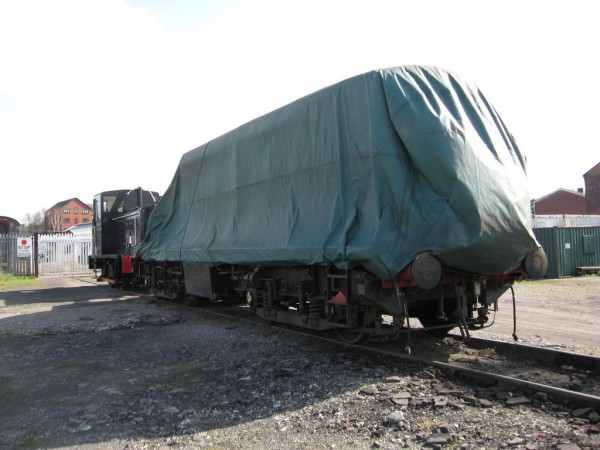 |
| Above : Tuesday morning and D2956 was used to shunt D8233 back to Baron St. © C15PS |
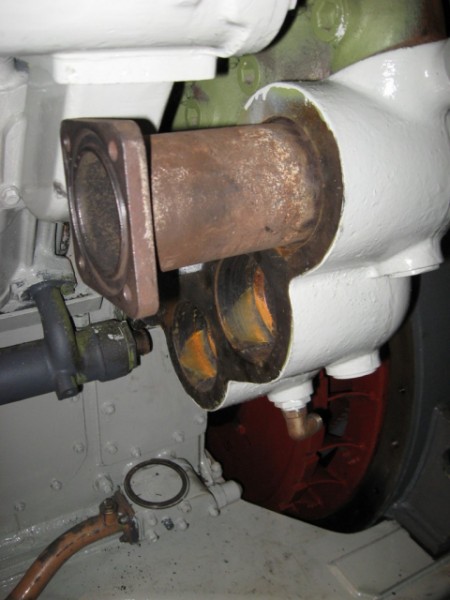 |
| Above : The first exhaust pipe is refitted into the Turbo cooling knuckle. © C15PS |
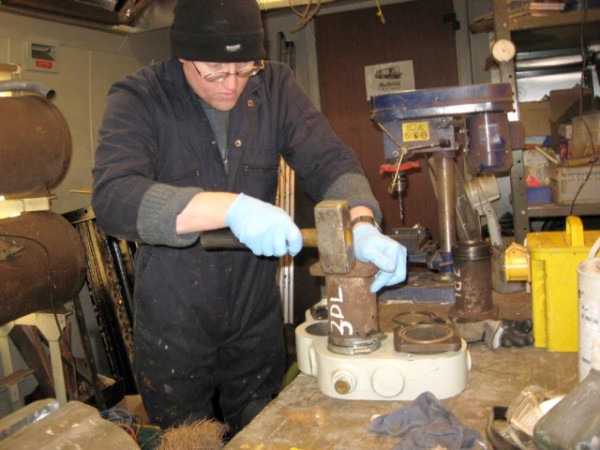 |
| Above : Jason tapps down one of the flange pipes into the central cooling knuckle. © C15PS |
 |
Above : The oil & water pipes needed to be picked out in seperate coloured paint.. © C15PS |
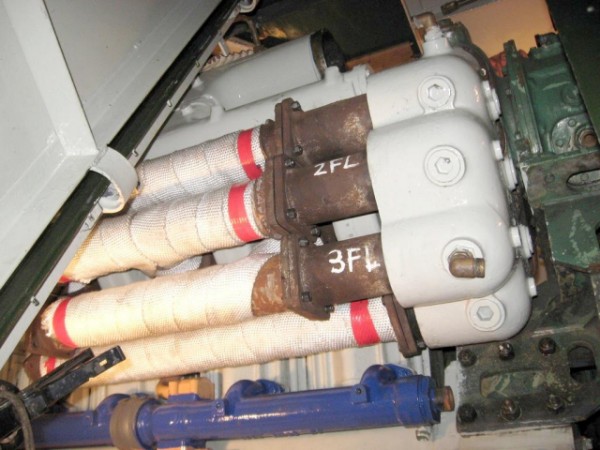 |
Above :
The four seperate branches of the rear section exhaust are now fitted.
© C15PS |
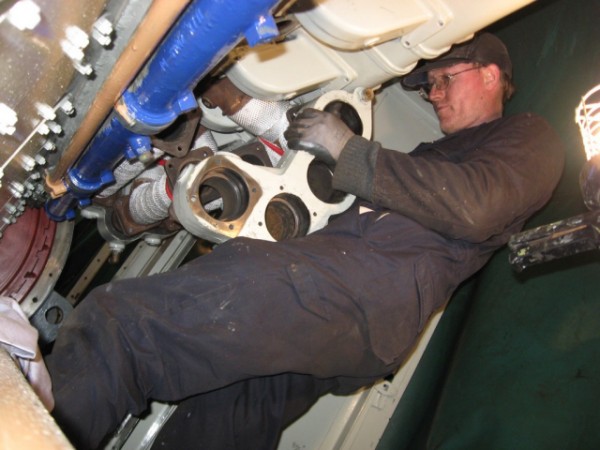 |
| Above : Jason tackles the fitting of the heavy & awkward central cooling knuckle. © C15PS |
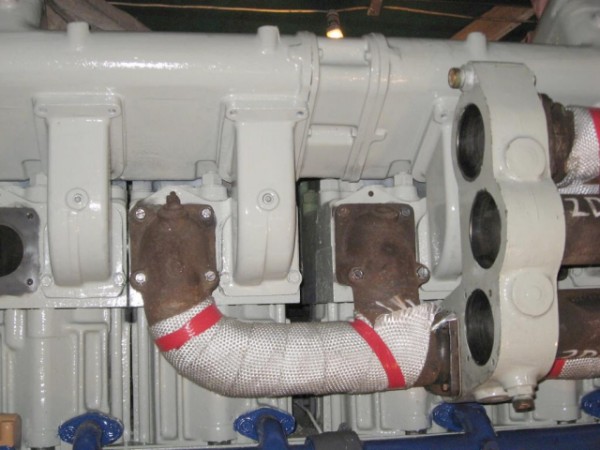 |
| Above : The duel manifold for Cylinders 5 & 6 was a real pig to get lined up properly. © C15PS |
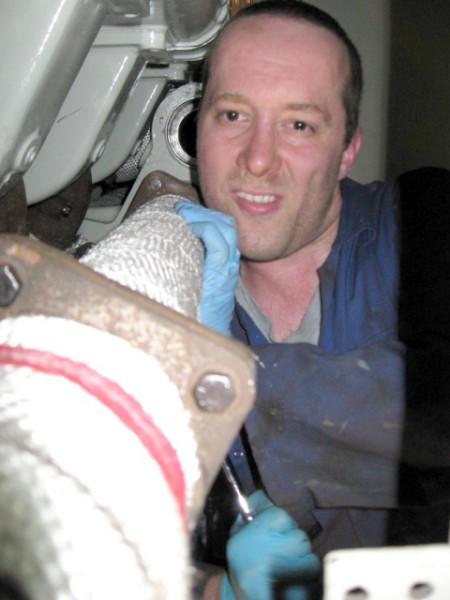 |
| Above : For the last couple of pipes Adam gave Jason a hand fitting them up. © C15PS |
 |
| Above : The exhaust is at long last fully re-fitted. © C15PS |
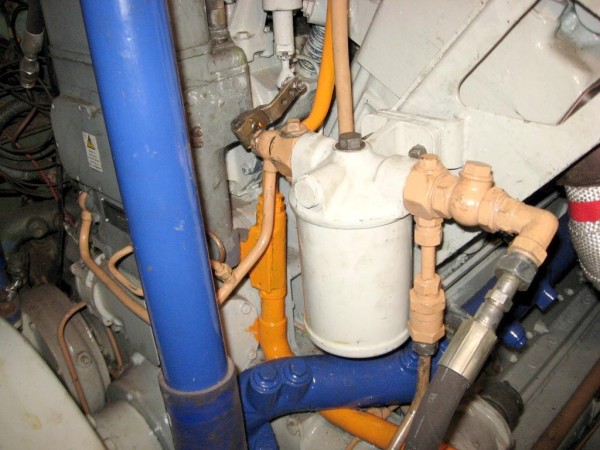 |
| Above : The Govenor oil filter and associated pipework & bracket are now back on. © C15PS |
Fancy Getting Involved? click on the You Can Help page